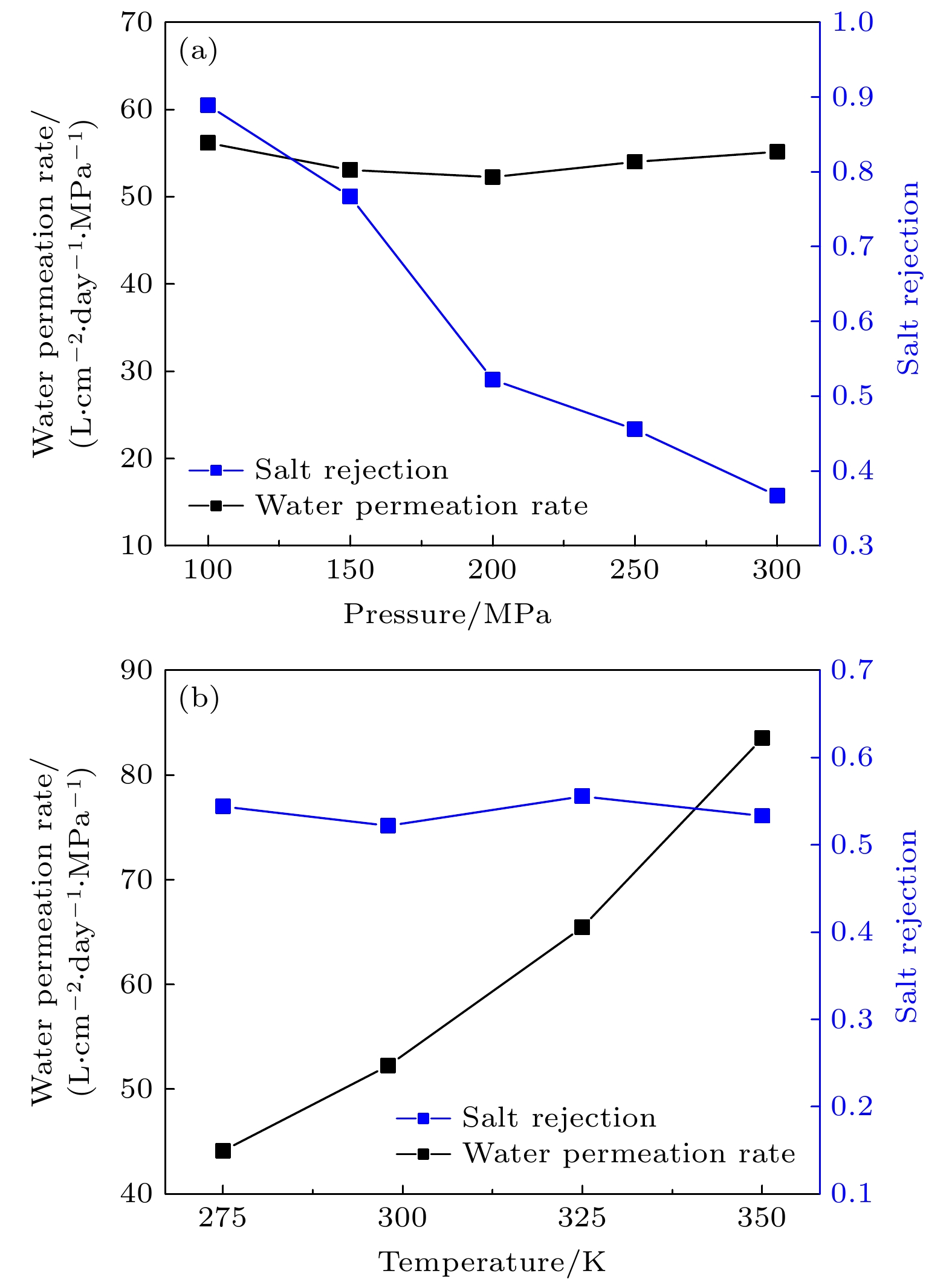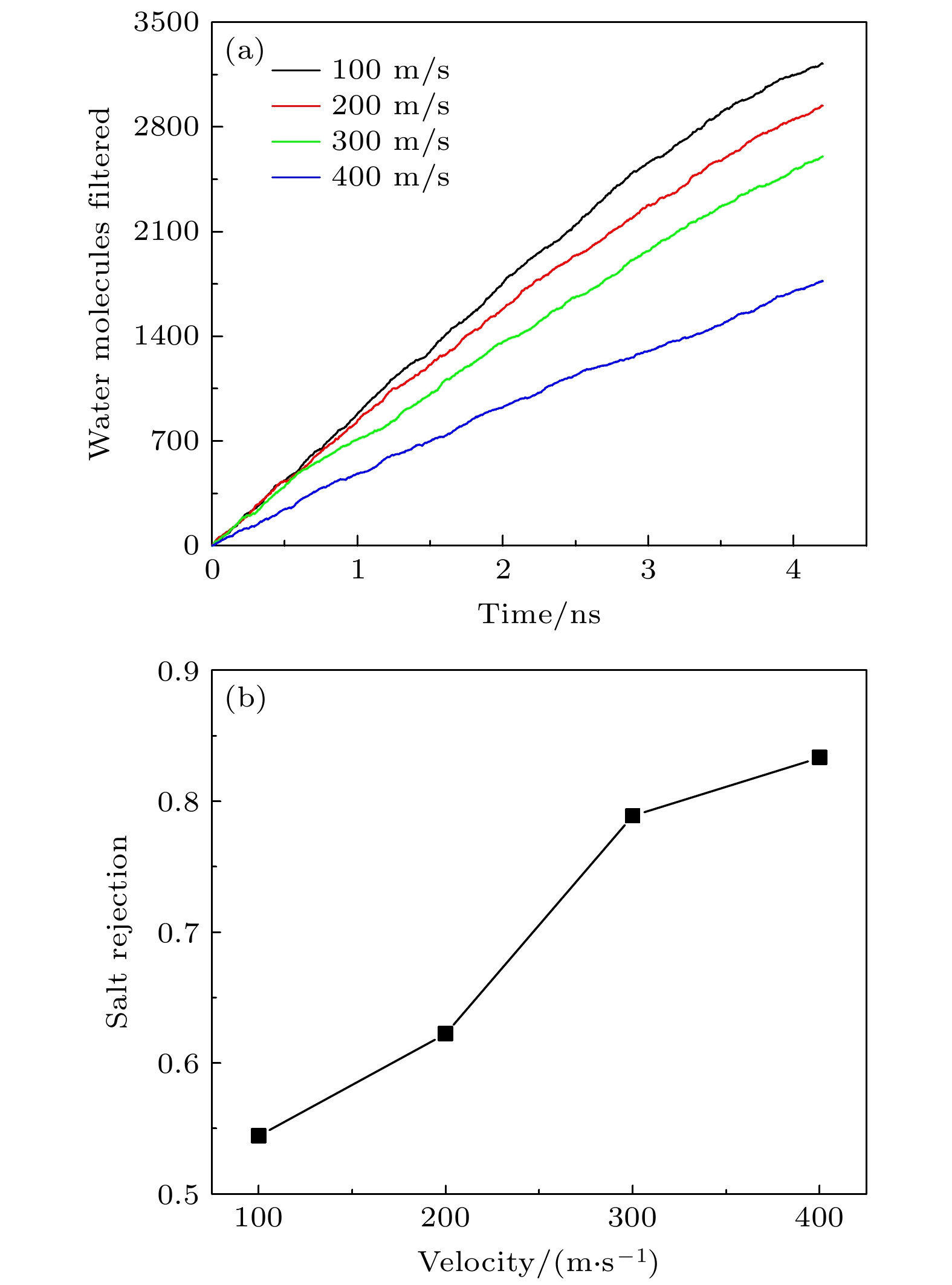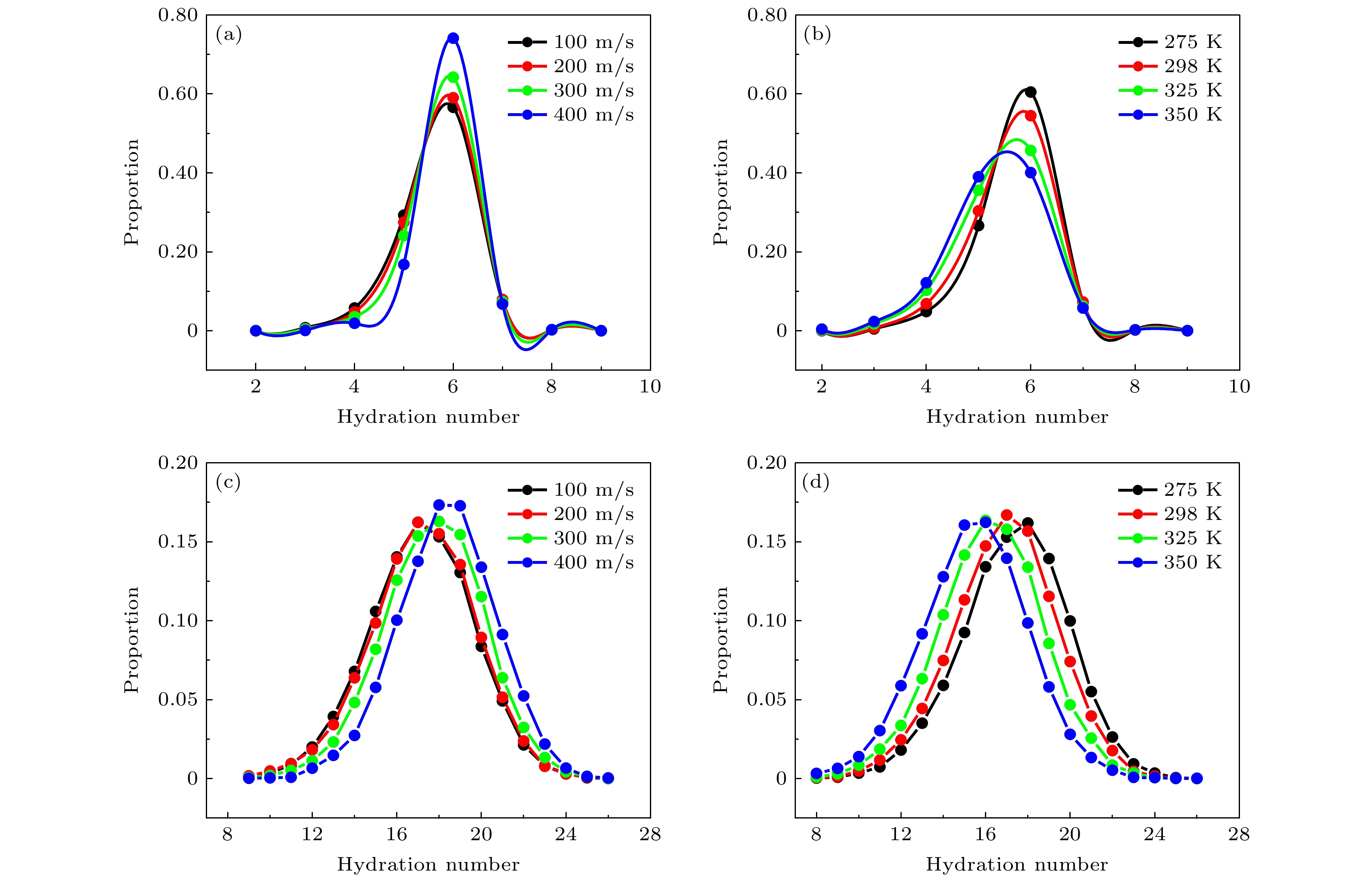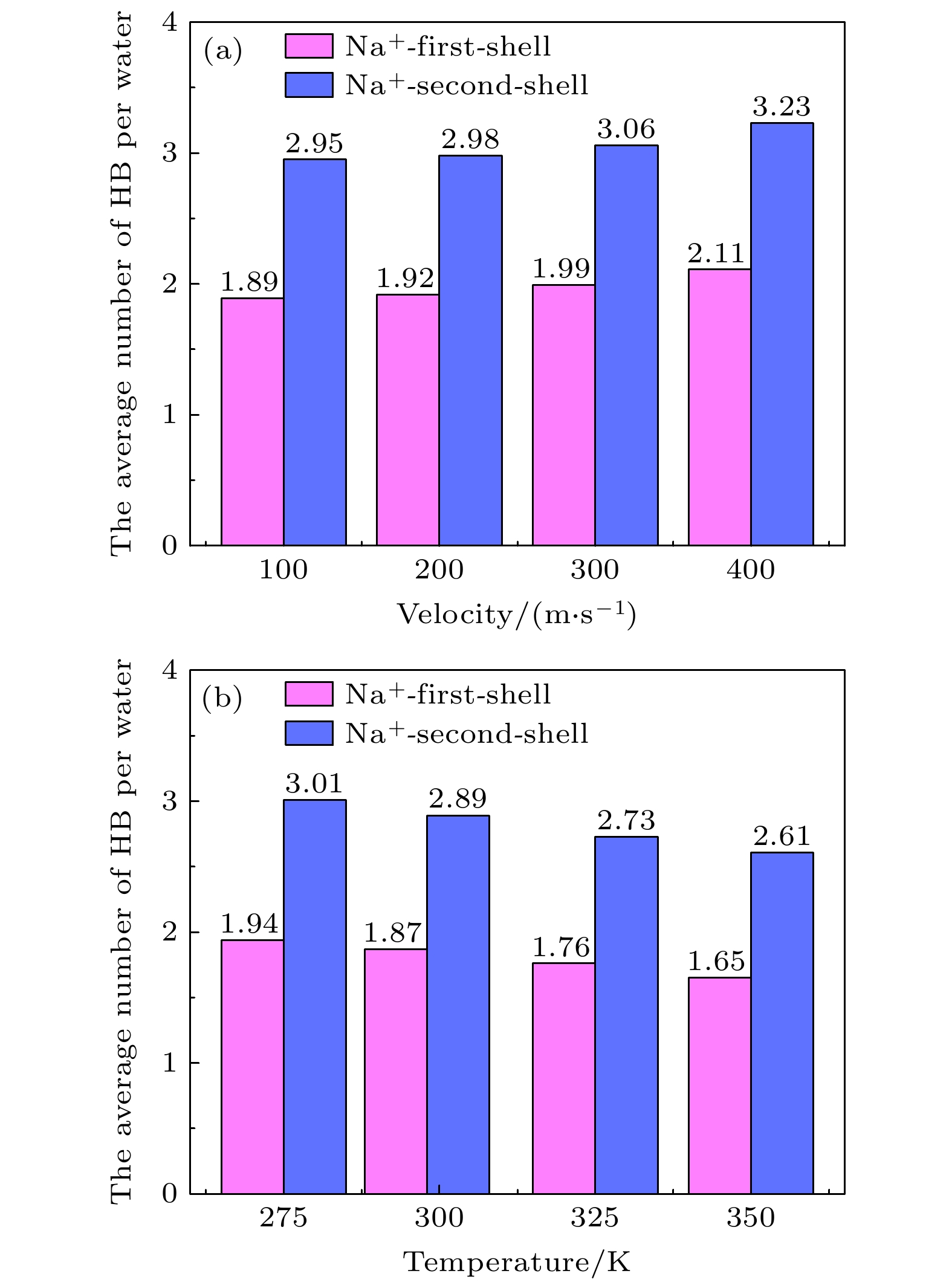-
Because of the high water flux and excellent ion rejection, the pores graphene is considered as a promising candidate material for fabricating the membranes in reverse osmosis (RO) process. Unfortunately, water molecules cannot pass through the perfect graphene, and how to effectively create a large number of nanopores with controllable size remains a challenge, which seriously prevents the practical application and development of graphene membrane for desalination. Recently, the emergence of pillared graphene (PGN) might open a new way for designing the graphene-based membranes, which can compensate for the deficiency of porous graphene membrane. The PGN has been extensively studied in gas storage and separation, and its RO characteristics and mechanism still remain unclear because the limitation of large area preparation in desalination. In this paper, the RO process of seawater through PGN membranes is investigated by molecular dynamics simulations, and the influences of the pressure within feed solution, temperature and the shearing of membrane on the desalination properties are considered. It is found that the water flux increases linearly with the pressure within feed solution increasing, and the PGN membrane with nanopore diameter of 0.8 nm can conduct water molecules but completely rejects high-concentration ions. As the diameter of nanopores increases to 1.2 nm, the rise of temperature can increase the permeability of water molecules, whereas the salt rejection is not appreciably sensitive to the temperature. Particularly, the shearing membrane can improve the salt rejection and hinder the water molecules from permeating at the same time. The designed PGN membrane exhibits excellent performance of water purification, and the ultrahigh water flux obtained in this work reaches 56.15 L·cm–2·day–1·MPa–1 with a salt rejection of 88.9%. Subsequently, the hydrogen bond dynamics is calculated in order to explain the variation of water permeability under different conditions. The result shows that the rise of temperature reduces the stability of hydrogen bonds and leads the water flux to increase, while the increase of shearing speed will enhance the stability of hydrogen bonds and inhibit water seepage. Furthermore, the analysis results of hydrogen bond and ionic hydration structure show that the shear motion on RO membrane will improve the stability of ionic hydration shell, which makes it more difficult for the ions to pass through nanopores by weakening the hydration shell. On the contrary, rising temperature will impair the strength of ionic hydration shell, leading more ions to pass through the RO membrane. The simulation results can provide an in-depth understanding of the desalination performance of PGN membrane under different key conditions, and further demonstrate the promising applications of graphene-based membrane in water desalination.
-
Keywords:
- pillared graphene /
- reverse osmosis /
- molecular dynamics /
- hydrogen bond /
- hydrated ion
[1] Elimelech M, Phillip W A 2011 Science 333 712
 Google Scholar
Google Scholar
[2] Park H B, Kamcev J, Robeson L M, Elimelech M, Freeman B D 2017 Science 356 1137
 Google Scholar
Google Scholar
[3] Lee K P, Arnot T C, Mattia D 2011 J. Membrane Sci. 370 1
 Google Scholar
Google Scholar
[4] Sint K, Wang B Y, Kral P 2008 J. Am. Chem. Soc. 130 16448
 Google Scholar
Google Scholar
[5] Cohen-Tanugi D, Grossman J C 2012 Nano Lett. 12 3602
 Google Scholar
Google Scholar
[6] Cohen-Tanugi D, Lin L C, Grossman J C 2016 Nano Lett. 16 1027
 Google Scholar
Google Scholar
[7] Cohen-Tanugi D, Grossman J C 2014 J. Chem. Phys. 141 074704
 Google Scholar
Google Scholar
[8] Zhang Z Q, Zhang F J, Liu Z, Cheng G G, Wang X D, Ding J N 2018 Nanomaterials (Basel) 8 805
 Google Scholar
Google Scholar
[9] Ali M E A, Wang L Y, Wang X Y, Feng X S 2016 Desalination 386 67
 Google Scholar
Google Scholar
[10] Hosseini M, Azamat J, Erfan-Niya H 2018 Appl. Surf. Sci. 427 1000
 Google Scholar
Google Scholar
[11] Jafarzadeh R, Azamat J, Erfan-Niya H 2018 Struct. Chem. 29 1845
 Google Scholar
Google Scholar
[12] Wang Y H, He Z J, Gupta K M, Shi Q, Lu R F 2017 Carbon 116 120
 Google Scholar
Google Scholar
[13] Surwade S P, Smirnov S N, Vlassiouk I V, Unocic R R, Veith G M, Sheng Dai S, Mahurin S M 2015 Nat. Nanotechnol. 10 459
 Google Scholar
Google Scholar
[14] Song L B, Guo Z G, Chai G B, Wang Z H, Li Y G, Luan Y B 2018 Carbon 140 210
 Google Scholar
Google Scholar
[15] Sakhavand N, Shahsavari R 2017 ACS Appl. Mater. Interfaces 9 39122
 Google Scholar
Google Scholar
[16] Wu C D, Fang T H, Lo J Y 2012 Int. J. Hydrogen Energy 37 14211
 Google Scholar
Google Scholar
[17] Lü R, Cruz-Silva E, Terrones M 2014 ACS Nano 8 4061
 Google Scholar
Google Scholar
[18] Wang Y C, Zhu Y B, Wang F C, Liu X Y, Wu H A 2017 Carbon 118 588
 Google Scholar
Google Scholar
[19] Duan K, Li Y J, Li L, Hu Y J, Wang X L 2018 Mater. Des. 147 11
 Google Scholar
Google Scholar
[20] Jiang H, Cheng X L 2018 J. Mol. Graphics Modell. 85 223
 Google Scholar
Google Scholar
[21] Hassani A, Mosavian M T H, Ahmadpour A, Farhadian N 2017 J. Nat. Gas Sci. Eng. 46 265
 Google Scholar
Google Scholar
[22] Zhou S N, Lu X Q, Wu Z H, Jin D L, Guo C, Wang M H, Wei S X 2016 Chem. Phys. Lett. 660 272
 Google Scholar
Google Scholar
[23] Wesolowski R P, Terzyk A P 2011 Phys. Chem. Chem. Phys. 13 17027
 Google Scholar
Google Scholar
[24] Tofighy M A, Shirazi Y, Mohammadi T, Pak A 2011 Chem. Eng. J. 168 1064
 Google Scholar
Google Scholar
[25] Corry B 2008 J. Phys. Chem. B 112 1427
 Google Scholar
Google Scholar
[26] 张忠强, 李冲, 刘汉伦, 葛道晗, 程广贵, 丁建宁 2018 物理学报 67 056102
 Google Scholar
Google Scholar
Zhang Z Q, Li C, Liu H L, Ge D J, Cheng G G, Ding J N 2018 Acta Phys. Sin. 67 056102
 Google Scholar
Google Scholar
[27] Plimpton S 1995 J. Comput. Phys. 117 1
 Google Scholar
Google Scholar
[28] Hummer G, Rasaiah J C, Noworyta J P 2001 Nature 414 188
 Google Scholar
Google Scholar
[29] Joung I S, Cheatham T E 2008 J. Phys. Chem. B 112 9020
 Google Scholar
Google Scholar
[30] Stuart S J, Tutein A B, Harrison J A 2000 J. Chem. Phys. 112 6472
 Google Scholar
Google Scholar
[31] Horn H W, Swope W C, Pitera J W, Madura J D, Dick T J, Hura G L, Head-Gordon T 2004 J. Chem. Phys. 120 9665
 Google Scholar
Google Scholar
[32] Chen B, Ivanov I, Klein M L, Parrinello M 2003 Phys. Rev. Lett. 91 215503
 Google Scholar
Google Scholar
[33] Todorova T, Seitsonen A P, Hutter J, Kuo I F, Mundy C J 2006 J. Phys. Chem. B 110 3685
 Google Scholar
Google Scholar
[34] 张忠强, 于凡顺, 刘珍, 张福建, 程广贵 2020 物理学报 69 098201
 Google Scholar
Google Scholar
Zhang Z Q, Yu F S, Liu Z, Zhang F J, Cheng G G 2020 Acta Phys. Sin. 69 098201
 Google Scholar
Google Scholar
[35] Xu H, Berne B J 2001 J. Phys. Chem. B 105 11929
 Google Scholar
Google Scholar
[36] Xie M, Gray S R 2016 Sep. Purif. Technol. 167 6
 Google Scholar
Google Scholar
[37] Li T G, Tu Q S, Li S F 2019 Desalination 451 182
 Google Scholar
Google Scholar
[38] Tu Q S, Li T G, Deng A, Zhu K, Liu Y F, Li S F 2018 Technology 6 36
 Google Scholar
Google Scholar
[39] Zhang Z Q, Li S F, Mi B X, Wang J B, Ding J N 2020 Sci. Adv. 6 eaba9471
 Google Scholar
Google Scholar
[40] Thomas M, Corry B, Hilder T A 2014 Small 10 1453
 Google Scholar
Google Scholar
-
图 1 (a) 压力驱动作用下以柱状石墨烯为反渗透膜的反渗透分子动力学模型图(其中灰色球为反渗透膜中的碳原子, 中间的红色、白色、蓝色、黄色球分别代表盐水中的氧原子、氢原子、钠离子、氯离子, 左边棕色球是用来提供驱动压力的单层石墨烯, 右侧棕色球是单层石墨烯挡板); (b)两个1.2 nm 孔径的RO膜
Figure 1. (a) Molecular dynamics model for pressure-driven reverse osmosis by a pillared graphene. The dark gray particles are carbon atoms of grapheme. The red, white, blue, and yellow spheres represent the oxygen atoms, hydrogen atoms, sodium ions, and chloride ions in the brine, respectively. The monolayer graphene at the left side is used to provide driving pressure, while the one at the right side is rigid boundary to confine the solvent. (b) RO membrane with two pores (diameter of 1.2 nm).
图 3 无剪切作用时, 孔径为1.2 nm的柱状石墨烯膜在不同压强和温度下的盐离子截留率与水分子渗透率 (a) 温度为298 K时, 不同压强下的盐离子截留率和水分子渗透率; (b) 压强为200 MPa时, 不同温度下的盐离子截留率和水分子渗透率
Figure 3. Without shearing, salt rejection verses water molecules permeability for the pillared graphene with pore diameter of 1.2 nm under different pressure and temperature: (a) Salt rejection and water permeation rate for the RO membrane under different pressure with the temperature of 298 K; (b) salt rejection and water permeation rate for the RO membrane under different temperature with the pressure of 200 MPa.
图 4 压强为200 MPa和温度为298 K时, 不同剪切速度下孔径为1.2 nm的柱状石墨烯膜透反渗透特性 (a) 透过柱状石墨烯膜的水分子数随时间的变化; (b) 柱状石墨烯膜在不同剪切速度下的盐离子截留率
Figure 4. With the pressure of 200 MPa and the temperature of 298 K, reverse osmosis properties of the pillared graphene with pore diameter of 1.2 nm under different shearing speed: (a) The number of water molecules passing through the pillared graphene membrane over time; (b) salt rejection of the pillared graphene membrane under different shearing speed.
图 5 在压强为200 MPa时, 不同剪切速度和温度下进给区每个水分子的平均氢键数和端口区每个水分子的平均氢键数 (a) 在不同剪切速度下(温度为298 K); (b) 在不同温度下(剪切速度为0)
Figure 5. With the pressure of 200 MPa, the average number of hydrogen bonds (HB) per water molecule in the feed and port region under different shearing speed and temperature: (a) Under different shearing speed (with the temperature of 298 K); (b) under different temperature (without shearing).
图 6 在压强为200 MPa时, 不同剪切速度和温度下氢键自相关函数C(t) (a) 在不同剪切速度下(温度为298 K); (b) 在不同温度下(剪切速度为0)
Figure 6. With the pressure of 200 MPa, the hydrogen bond autocorrelation function C(t) under different shearing speed and temperature: (a) Under different shearing speed (with the temperature of 298 K); (b) under different temperature (without shearing).
图 8 水合壳模型图 (粉色的球代表第一水合壳中的氧原子, 红色的球代表第二水合层中的氧原子, 白色和紫色的球分别代表氢原子和钠离子) (a) 在进给区中; (b) 在柱状石墨烯纳米通道内
Figure 8. Models of hydration shell: (a) In the feed region; (b) in pillared graphene nanochannels. The pink spheres represent the oxygen atoms in the first hydration shell. The red spheres represent the oxygen atoms in the second hydration shell. The white and purple spheres represent the hydrogen atoms andsodium ions, respectively.
图 9 在不同条件下Na+第一与第二水合壳中水分子数分布 (a) 在不同剪切速度下Na+第一水合壳中水分子数分布; (b) 在不同温度下Na+第一水合壳中水分子数分布; (c) 在不同剪切速度下Na+第二水合壳中水分子数分布; (d) 在不同温度下Na+第二水合壳中水分子数分布
Figure 9. Hydration number distribution of Na+ in the first and second hydration shell under different conditions: (a) Hydration number distribution of Na+ in the first hydration shell at different shearing speed; (b) hydration number distribution of Na+ in the first hydration shell at different temperature; (c) hydration number distribution of Na+ in the second hydration shell at different shearing speed; (d) hydration number distribution of Na+ in the second hydration shell at different temperature.
表 1 LJ势能参数
Table 1. LJ potential parameters.
Elements C (sp2) Ow Hw Na+ Cl– ε/(kcal·mol–1) 0.0859 0.16275 0 0.1684 0.0117 σ/Å 3.3997 3.16435 0 2.2589 5.1645 q/e 0 –1.0484 0.5242 1 –1 -
[1] Elimelech M, Phillip W A 2011 Science 333 712
 Google Scholar
Google Scholar
[2] Park H B, Kamcev J, Robeson L M, Elimelech M, Freeman B D 2017 Science 356 1137
 Google Scholar
Google Scholar
[3] Lee K P, Arnot T C, Mattia D 2011 J. Membrane Sci. 370 1
 Google Scholar
Google Scholar
[4] Sint K, Wang B Y, Kral P 2008 J. Am. Chem. Soc. 130 16448
 Google Scholar
Google Scholar
[5] Cohen-Tanugi D, Grossman J C 2012 Nano Lett. 12 3602
 Google Scholar
Google Scholar
[6] Cohen-Tanugi D, Lin L C, Grossman J C 2016 Nano Lett. 16 1027
 Google Scholar
Google Scholar
[7] Cohen-Tanugi D, Grossman J C 2014 J. Chem. Phys. 141 074704
 Google Scholar
Google Scholar
[8] Zhang Z Q, Zhang F J, Liu Z, Cheng G G, Wang X D, Ding J N 2018 Nanomaterials (Basel) 8 805
 Google Scholar
Google Scholar
[9] Ali M E A, Wang L Y, Wang X Y, Feng X S 2016 Desalination 386 67
 Google Scholar
Google Scholar
[10] Hosseini M, Azamat J, Erfan-Niya H 2018 Appl. Surf. Sci. 427 1000
 Google Scholar
Google Scholar
[11] Jafarzadeh R, Azamat J, Erfan-Niya H 2018 Struct. Chem. 29 1845
 Google Scholar
Google Scholar
[12] Wang Y H, He Z J, Gupta K M, Shi Q, Lu R F 2017 Carbon 116 120
 Google Scholar
Google Scholar
[13] Surwade S P, Smirnov S N, Vlassiouk I V, Unocic R R, Veith G M, Sheng Dai S, Mahurin S M 2015 Nat. Nanotechnol. 10 459
 Google Scholar
Google Scholar
[14] Song L B, Guo Z G, Chai G B, Wang Z H, Li Y G, Luan Y B 2018 Carbon 140 210
 Google Scholar
Google Scholar
[15] Sakhavand N, Shahsavari R 2017 ACS Appl. Mater. Interfaces 9 39122
 Google Scholar
Google Scholar
[16] Wu C D, Fang T H, Lo J Y 2012 Int. J. Hydrogen Energy 37 14211
 Google Scholar
Google Scholar
[17] Lü R, Cruz-Silva E, Terrones M 2014 ACS Nano 8 4061
 Google Scholar
Google Scholar
[18] Wang Y C, Zhu Y B, Wang F C, Liu X Y, Wu H A 2017 Carbon 118 588
 Google Scholar
Google Scholar
[19] Duan K, Li Y J, Li L, Hu Y J, Wang X L 2018 Mater. Des. 147 11
 Google Scholar
Google Scholar
[20] Jiang H, Cheng X L 2018 J. Mol. Graphics Modell. 85 223
 Google Scholar
Google Scholar
[21] Hassani A, Mosavian M T H, Ahmadpour A, Farhadian N 2017 J. Nat. Gas Sci. Eng. 46 265
 Google Scholar
Google Scholar
[22] Zhou S N, Lu X Q, Wu Z H, Jin D L, Guo C, Wang M H, Wei S X 2016 Chem. Phys. Lett. 660 272
 Google Scholar
Google Scholar
[23] Wesolowski R P, Terzyk A P 2011 Phys. Chem. Chem. Phys. 13 17027
 Google Scholar
Google Scholar
[24] Tofighy M A, Shirazi Y, Mohammadi T, Pak A 2011 Chem. Eng. J. 168 1064
 Google Scholar
Google Scholar
[25] Corry B 2008 J. Phys. Chem. B 112 1427
 Google Scholar
Google Scholar
[26] 张忠强, 李冲, 刘汉伦, 葛道晗, 程广贵, 丁建宁 2018 物理学报 67 056102
 Google Scholar
Google Scholar
Zhang Z Q, Li C, Liu H L, Ge D J, Cheng G G, Ding J N 2018 Acta Phys. Sin. 67 056102
 Google Scholar
Google Scholar
[27] Plimpton S 1995 J. Comput. Phys. 117 1
 Google Scholar
Google Scholar
[28] Hummer G, Rasaiah J C, Noworyta J P 2001 Nature 414 188
 Google Scholar
Google Scholar
[29] Joung I S, Cheatham T E 2008 J. Phys. Chem. B 112 9020
 Google Scholar
Google Scholar
[30] Stuart S J, Tutein A B, Harrison J A 2000 J. Chem. Phys. 112 6472
 Google Scholar
Google Scholar
[31] Horn H W, Swope W C, Pitera J W, Madura J D, Dick T J, Hura G L, Head-Gordon T 2004 J. Chem. Phys. 120 9665
 Google Scholar
Google Scholar
[32] Chen B, Ivanov I, Klein M L, Parrinello M 2003 Phys. Rev. Lett. 91 215503
 Google Scholar
Google Scholar
[33] Todorova T, Seitsonen A P, Hutter J, Kuo I F, Mundy C J 2006 J. Phys. Chem. B 110 3685
 Google Scholar
Google Scholar
[34] 张忠强, 于凡顺, 刘珍, 张福建, 程广贵 2020 物理学报 69 098201
 Google Scholar
Google Scholar
Zhang Z Q, Yu F S, Liu Z, Zhang F J, Cheng G G 2020 Acta Phys. Sin. 69 098201
 Google Scholar
Google Scholar
[35] Xu H, Berne B J 2001 J. Phys. Chem. B 105 11929
 Google Scholar
Google Scholar
[36] Xie M, Gray S R 2016 Sep. Purif. Technol. 167 6
 Google Scholar
Google Scholar
[37] Li T G, Tu Q S, Li S F 2019 Desalination 451 182
 Google Scholar
Google Scholar
[38] Tu Q S, Li T G, Deng A, Zhu K, Liu Y F, Li S F 2018 Technology 6 36
 Google Scholar
Google Scholar
[39] Zhang Z Q, Li S F, Mi B X, Wang J B, Ding J N 2020 Sci. Adv. 6 eaba9471
 Google Scholar
Google Scholar
[40] Thomas M, Corry B, Hilder T A 2014 Small 10 1453
 Google Scholar
Google Scholar
Catalog
Metrics
- Abstract views: 8883
- PDF Downloads: 100
- Cited By: 0















 DownLoad:
DownLoad:









